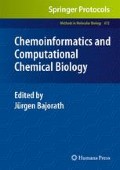Abstract
The exploration of structure–activity relationships (SARs) is a major challenge in medicinal chemistry and usually focuses on compound potency for individual targets. However, selectivity of small molecules that are active against related targets is another critical parameter in chemical lead optimization. Here, an integrative approach for the systematic analysis of SARs and structure–selectivity relationships (SSRs) of small molecules is presented. The computational methodology is described and a cathepsin inhibitor set is used to discuss key aspects of the analysis. Combining a numerical scoring scheme and graphical visualization of molecular networks, the approach enables the identification of different local SAR and SSR environments. Comparative analysis of these environments reveals variable relationships between molecular structure, potency, and selectivity. Furthermore, key compounds are identified that are involved in the formation of activity and/or selectivity cliffs and often display structural features that determine compound selectivity.
Access this chapter
Tax calculation will be finalised at checkout
Purchases are for personal use only
References
Johnson, M. A. and Maggiora, G. M., eds. (1990) Concepts and applications of molecular similarity. New York, NY: Wiley.
Maggiora, G. M. (2006) On outliers and activity cliffs – Why QSAR often disappoints J Chem Inf Model 46, 1535.
Peltason, L. and Bajorath, J. (2007) Molecular similarity analysis uncovers heterogeneous structure–activity relationships and variable activity landscapes Chem Biol 14, 489–497.
Bajorath, J., Peltason, L., Wawer, M., Guha, R., Lajiness, M. S., and van Drie, J. (2009) Navigating structure–activity landscapes Drug Discov Today 14, 698–705.
Peltason, L. and Bajorath, J. (2009) Systematic computational analysis of structure–activity relationships: Concepts, challenges, and recent advances Future Med Chem 1, 451–466.
Hopkins, A. L. (2008) Network pharmacology: The next paradigm in drug discovery Nat Chem Biol 4, 682–690.
Peltason, L., Hu, Y., and Bajorath, J. (2009) From structure–activity to structure–selectivity relationships: Quantitative assessment, selectivity cliffs, and key compounds Chem Med Chem 4 , 1864–1873
Bajorath, J. (2008) Computational analysis of ligand relationships within target families Curr Opin Chem Biol 12, 352–358.
Peltason, L. and Bajorath, J. (2007) SAR index: Quantifying the nature of structure–activity relationships J Med Chem 50, 5571–5578.
Wawer, M., Peltason, L., Weskamp, N., Teckentrup, A., and Bajorath, J. (2008) Structure–activity relationship anatomy by network-like similarity graphs and local structure–activity relationship indices J Med Chem 51, 6075–6084.
MACCS Structural Keys: Symyx Software, San Ramon, CA (USA).
MOE (Molecular Operating Environment): Chemical Computing Group Inc., Montreal, Quebec (Canada).
Ward, J. H. (1963) Hierarchical grouping to optimize an objective function J Am Stat Assoc 58, 236–244.
MDDR (MDL Drug Data Report): Symyx Software, San Ramon, CA (USA).
Stumpfe, D., Geppert, H., and Bajorath, J. (2008) Methods for computer-aided chemical biology. Part 3: Analysis of structure–selectivity relationships through single- or dual-step selectivity searching and Bayesian classification Chem Biol Drug Des 71, 518–528.
Author information
Authors and Affiliations
Editor information
Editors and Affiliations
Rights and permissions
Copyright information
© 2011 Humana Press
About this protocol
Cite this protocol
Peltason, L., Bajorath, J. (2011). Computational Analysis of Activity and Selectivity Cliffs. In: Bajorath, J. (eds) Chemoinformatics and Computational Chemical Biology. Methods in Molecular Biology, vol 672. Humana Press, Totowa, NJ. https://doi.org/10.1007/978-1-60761-839-3_4
Download citation
DOI: https://doi.org/10.1007/978-1-60761-839-3_4
Published:
Publisher Name: Humana Press, Totowa, NJ
Print ISBN: 978-1-60761-838-6
Online ISBN: 978-1-60761-839-3
eBook Packages: Springer Protocols

